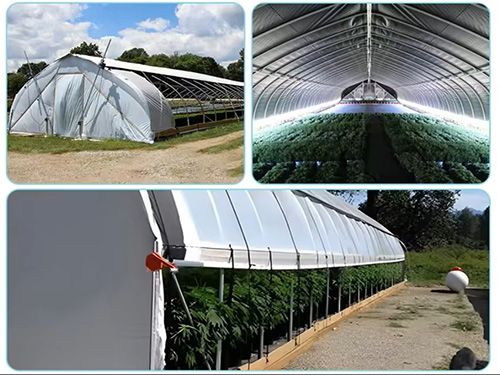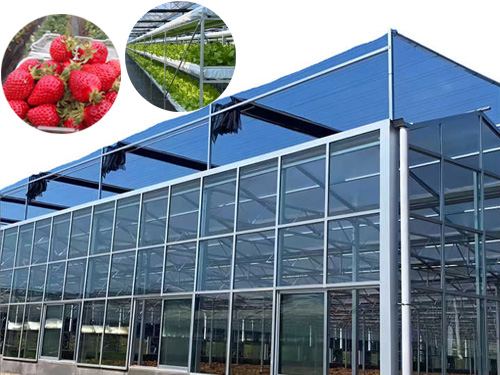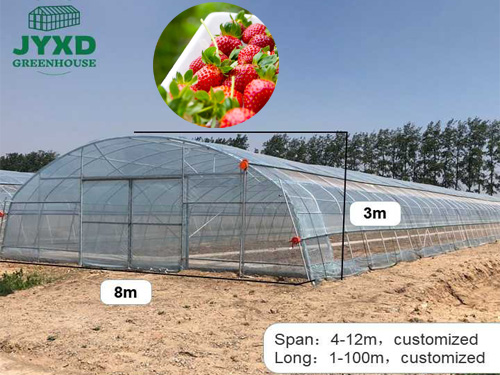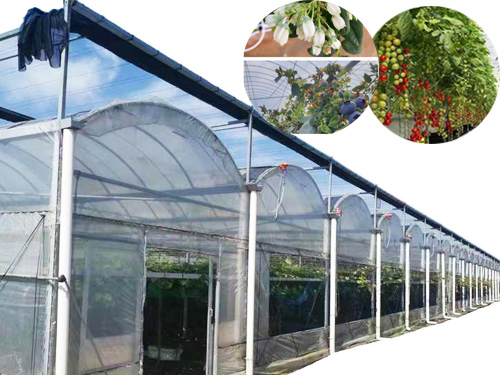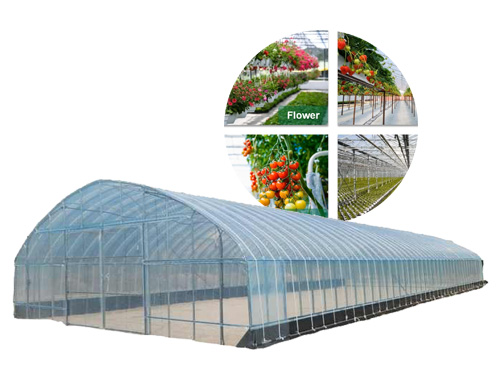NEWS DETAILS
NEWS INFORMATION
High-altitude Greenhouses: How to Optimize Plant Growth in Low-oxygen Environments
AUTHOR:jyxd-greenhouse DATE:2024-11-25 21:41:41 HITS:198
With the advancement of global agricultural technology, more and more farmers and enterprises are choosing to build greenhouses in high-altitude regions for agricultural production. High-altitude greenhouses not only make effective use of land resources but also help improve the yield and quality of certain crops. However, due to the low oxygen levels and cold climates in high-altitude regions, optimizing plant growth in such low-oxygen environments presents a major challenge for growers. This article explores the construction and management of high-altitude greenhouses and shares how advanced technologies and management strategies can improve crop growth efficiency in low-oxygen environments.
1. Challenges and Opportunities of High-altitude Greenhouses
High-altitude areas typically feature lower oxygen content and greater temperature fluctuations, which present many challenges for crop growth. However, greenhouses can create a stable, controlled environment, reducing the impact of external adverse factors, which is why their application in high-altitude regions is increasingly widespread.
a) Impact of Low Oxygen on Plant Growth
At high altitudes, the oxygen content is significantly lower than at sea level, which has a considerable impact on plants' photosynthesis and respiration. Since photosynthesis relies on carbon dioxide and water, and the efficiency of these processes is affected by low oxygen, plant growth tends to slow down.
b) Climate Characteristics of High-altitude Areas
Low temperatures: The temperatures during the day are lower in high-altitude areas, with large temperature variations at night, which can affect normal plant growth.
Strong ultraviolet radiation: Due to the thinner air, the intensity of UV radiation increases, which can damage crops.
Despite these challenges, greenhouse farming in high-altitude areas still holds great potential. By employing proper greenhouse design and management, these adverse factors can be greatly mitigated, and the unique climatic advantages of high-altitude regions can even be leveraged to improve crop quality.
Keywords: High-altitude Greenhouses, Low Oxygen Environment, Greenhouse Design
2. Construction and Design of High-altitude Greenhouses
Designing a high-altitude greenhouse requires consideration of the thin air and large temperature fluctuations, while also creating a stable environment suitable for plant growth.
a) Greenhouse Structure and Insulation Design
Insulation is the top priority in the design of high-altitude greenhouses. Due to the large temperature fluctuations, it is essential to maintain constant temperature and humidity. Common greenhouse designs include:
Double-layer membrane greenhouse: Double-layer membranes can effectively increase insulation, reducing heat loss. Additionally, the high light transmission of the membrane materials ensures ample sunlight for photosynthesis.
Glass greenhouse: Suitable for crops that require higher light transmission, although the construction cost is higher, it allows for better environmental control.
b) Ventilation and Oxygen Management
A low-oxygen environment requires effective management of internal air circulation to maintain sufficient oxygen levels:
Smart ventilation systems: Automated greenhouse ventilation systems can adjust airflow based on internal oxygen levels and temperature, ensuring the necessary oxygen concentration for plant growth.
Air circulation systems: By circulating air, oxygen is evenly distributed throughout the greenhouse, preventing localized oxygen shortages and promoting balanced plant growth.
c) UV Shielding and Protection
At high altitudes, the UV radiation is stronger, and prolonged exposure can damage plant cells and leaves. Therefore, greenhouse designs must include UV protection films to reduce UV damage while ensuring adequate sunlight for photosynthesis.
Keywords: Greenhouse Design, Double-layer Membrane Greenhouse, Smart Ventilation
3. Plant Selection and Cultivation in High-altitude Greenhouses
When growing plants in high-altitude greenhouses, it is essential to choose varieties that are highly adaptable, cold-resistant, and low-oxygen tolerant, and apply scientific cultivation methods to adapt to the unique climatic conditions.
a) Selection of Cold-resistant and Low-oxygen-tolerant Plant Varieties
In high-altitude greenhouses, selecting crops that are tolerant to cold and low-oxygen environments is crucial for improving yield and quality. Some crops suitable for high-altitude greenhouse cultivation include:
Strawberries: Strawberries are cold-resistant fruits that can thrive in the low temperatures and low-oxygen environment of high-altitude areas.
Tomatoes: Tomatoes are resistant to low temperatures and can grow in high-altitude greenhouses, especially short-day varieties, which can maintain high yields even under lower light conditions.
Leafy vegetables: Crops like lettuce and spinach, which are low-oxygen and cold-tolerant, are suitable for greenhouse cultivation.
b) Detailed Cultivation Management
To improve plant growth efficiency in the low-oxygen environment of high-altitude regions, detailed cultivation management is crucial. The following aspects are particularly important:
Temperature control: Through smart temperature control systems inside the greenhouse, the temperature can be maintained within the optimal range for plant growth.
Water management: Given the dry climate of high-altitude areas, effective water management within the greenhouse is vital. Drip irrigation systems can be used to supply water precisely to plant roots, reducing water waste.
Nutrient management: In a low-oxygen environment, plants absorb nutrients more slowly, so it is essential to precisely control the amount of fertilizer applied at different growth stages of the plant.
Keywords: Plant Selection, Cold-resistant Crops, Cultivation Management
4. Oxygen Supplementation Techniques in High-altitude Greenhouses
Low oxygen is a significant challenge in high-altitude greenhouses. Effective oxygen supplementation techniques are essential for promoting plant growth.
a) Oxygen Enrichment Systems
Oxygen enrichment systems can increase the oxygen concentration inside the greenhouse, ensuring that plants can carry out normal photosynthesis and respiration. Oxygen enrichment systems include:
Oxygen generators: These can provide pure oxygen to the greenhouse, raising the oxygen concentration in the air.
Gas regulation systems: These systems can adjust the concentrations of oxygen and carbon dioxide based on the needs of the plants, optimizing photosynthesis efficiency.
b) Lighting and Light Management
Due to the strong sunlight and UV radiation at high altitudes, light management within the greenhouse is essential. Proper light control helps plants perform effective photosynthesis and avoid excessive UV exposure.
LED supplemental lighting: In conditions of insufficient light, LED lights can provide a stable light environment to promote plant growth.
Shade nets: During times of intense sunlight, shade nets can reduce UV radiation, protecting plants from damage.
Keywords: Oxygen Enrichment Systems, Oxygen Supplementation, Light Management
5. Successful Case Study: Application of High-altitude Greenhouses
Case Overview: In a high-altitude region in China, an agricultural company successfully cultivated strawberries and tomatoes in a high-altitude greenhouse, achieving remarkable results.
Greenhouse design: The company used a double-layer membrane greenhouse, combined with smart temperature control systems and oxygen enrichment equipment, to maintain stable temperature and oxygen levels inside the greenhouse.
Crop selection: Cold-resistant strawberry and tomato varieties were chosen, along with detailed water and fertilizer management to ensure healthy plant growth.
Oxygen management: Oxygen generators were used to periodically supplement oxygen, ensuring that plants could carry out normal photosynthesis.
Case Results: This project successfully overcame the limitations of the low-oxygen environment at high altitudes, not only ensuring high yields of strawberries and tomatoes but also improving product quality and market competitiveness.
Keywords: Successful Case Study, High-altitude Greenhouse Application, Strawberry Cultivation
6. Conclusion
High-altitude greenhouse farming faces challenges such as low oxygen levels and large temperature fluctuations. However, through proper design and detailed management, growers can overcome these difficulties and achieve efficient production. Selecting adaptable crops, employing advanced oxygen enrichment technologies, and improving light, temperature, and humidity management are key factors for optimizing plant growth in high-altitude regions. With technological advancements, high-altitude greenhouses will have even greater agricultural potential globally, meeting the growing food demand.
We hope this article on high-altitude greenhouses provides valuable insights and helps you successfully implement greenhouse farming in high-altitude regions. If you have any questions or suggestions, feel free to leave a comment!
Hebei Juyou Xinda Greenhouse Facilities Co.,Ltd.
Copyright © 2024-2025 https://www.jyxd-greenhouse.com. All Rights Reserved Hebei Juyou Xinda Greenhouse Facilities Co.,Ltd.Copyright





 Current Location:
Current Location:


